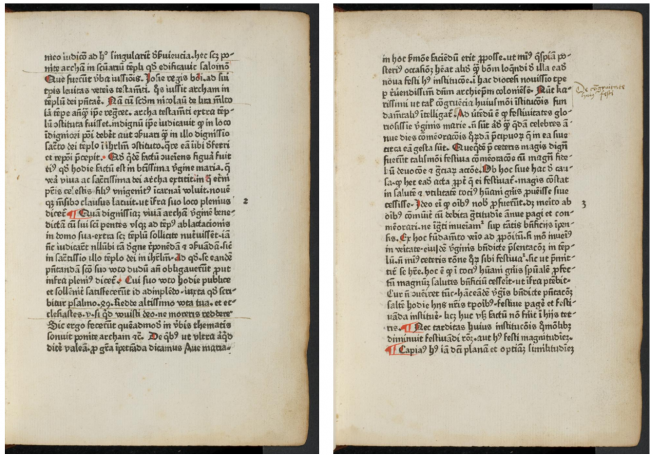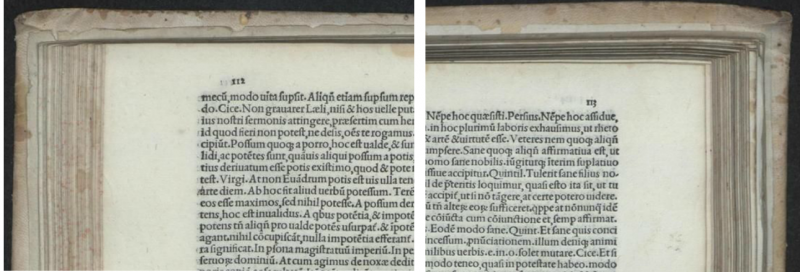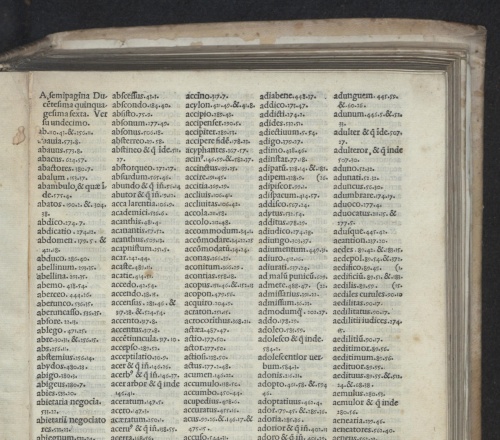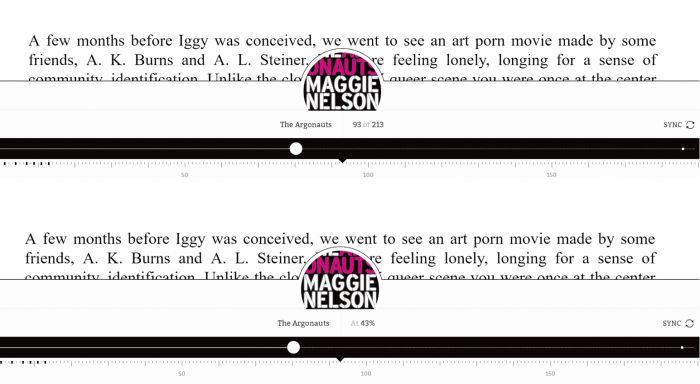Page Numbers
Page numbering is a ubiquitous feature among modern books, but it is something readers take for granted. Though it seems like a simple device, it truly is an apparatus that had to be invented and developed. We should take a moment to appreciate pagination, as current reading technologies may soon render it obsolete.
Pagination is the consecutive numbering of book’s pages on both the recto and verso—front and back—sides. [1] Pagination supplanted foliation, another type of sequential numbering; foliation denotes leaves on its recto side.
History
Most books before the 1500s lacked page numbers. Around 1450, less than an estimated ten percent of manuscript books contained pagination, but by the early 16th century, readers were relying on them to find their way through texts. [2] As a modern reader, it is hard to imagine navigating a book without pagination, yet somehow people did for many centuries.
Scrolls
It may help to realize that page numbering was not a concept in the early history of the book due to the reading culture established by scrolls. Scroll culture lacked pagination because a scroll’s “text was continuous and lacked page breaks." [3] Though Egyptians, Greeks, and Romans of antiquity divided scrolls’ text and images into columns called paginae, the emergence of the codex—a collection of leaves bound on one side—after the first century AD introduced a new organizational mode through pages. [1]
Codex
As Bonnie Mak points out in How the Page Matters, “as a single sheet, the page may stand free of an obvious attachment with others of its kind. The material boundaries of the solitary page not only circumscribe the space of communication, they also circumscribe the message itself; there is nothing more to be read than what is one the page."
Although the materiality of pages in a codex changed how readers approach a text, it still took a long time to shift reading culture and necessitate the use of pagination.

This is partly because page numbering was not necessary to produce a codex. Bookbinders did not assemble books by each page but instead dealt with groups of several leaves at once. To arrange these sections in the right order, binders marked each section with a letter of the alphabet, usually in the bottom right corner of the recto sheet. Numbers followed the letters to indicate the sequence of the leaves. Considering that this mark, called a “signature,” contained a combination of letters and numbers, and also considering that sections might have had an unequal number of leaves, these signatures were primarily for the artisans’ reference and not for the convenience of readers. [4]. However, the custom of signature marks may have been a predecessor to pagination, as the earliest examples of pagination have no signatures, and vice versa [4]. Such an example is the book pictured in Figure 1 published in 1488; while there are signature marks throughout the pages, a book owner added his own page numbers in the top margins.
Reading culture
However, the habits of readers during early book history also made page numbers not necessary, at first. While today most of the literate population read “extensively” by reading a large number of texts (often only once), readers of antiquity read “intensively,” returning to only a few books repeatedly. [5] The manuscript production process influences the volume of books people read. Books were difficult to come by because of expensive parchment, but also because of the laborious process of copying and illuminating a hand-written manuscript. The painstaking nature of the process is clear by the length of time required to faithfully reproduce a manuscript: scribes usually copied three to four pages per day. [3] The scarcity of books results in early readers knowing their texts well, sometimes studying them to the point of memorization. Therefore, page numbers as reminders of location are less necessary to an intensive reader who knows the text by heart compared to an extensive reader who may be glancing over a text once for reference. An example of intensive reading is lectio reading, the predominant model for reading in the early Middle Ages. [1] Back then, “reading, understood as a spiritual exercise, emphasized the slow and steady contemplation of a single text”—that text being the Bible. [1] It is easier to understand, then, how monks were able to refer to specific verses by just quoting its first few words.

Still, artisans and readers developed devices to help navigate numberless texts. Their repertoire of markings, called paratexts, mostly involved decorative elements to help divide the text into subgroups and draw attention to some. For example, scribes could alter script style to highlight a prestigious passage, Latin words, names, or quotations. [6] “Capitulo,” or chapters, could split up the text into digestible sections. Running headers at the top of pages would indicate which section the reader was in. Illuminators could also paint enlarged or colored letters for titles and subtitles of new sections. In Figure 2, the Bible pictured was published by Anton Koberger in 1475, and ornamental letters indicate the beginning of capitulos. However, it is clear that these letters are essential for reference and not just decoration when looking at the same Bible’s Psalms, a commonly-read book of the Bible. Here, the colored letters are much more frequent to facilitate a reader’s eye to a specific verse.

Readers developed their own paratexts, as well. Not only were book owners expected to write in their own page numbers, but they also drew their own markers in page margins. Commonly, readers drew a hand called a manicule to literally point out a passage of interest to help find it later.
Foliation and pagination introduced
In the earliest extant example of foliation, a religious text printed in 1470 by the Cologne printer Arnold ter Hoernen, we see that even with numbers marking each right-hand leaf, bookmakers still included dashes of color to break up the text. The presence of such illumination indicates that readers still relied on these paratexts even in the advent of leaf and page numbering.

By the twelfth century, Mak explains that “the development of universities fostered analytical modes of engagement with text, especially in the urban, scholarly communities. Texts were once again being consulted for reference purposes.” [1] Such social factors that brought attention to secular matters, along with the invention of the printing press in the mid-fifteenth century that accelerated book production to a mass-scale, ushered in new reading customs. Therefore, a new reading culture necessitated new paratextual features such as indices—and page numbers—for analytical purposes.
The earliest extant example of pagination is Aldus Manutius’s edition of Niccolo Perotti’s Cornucopiae, published in 1499. [7] As a 700-page encyclopedia of the Latin language, it makes sense that the innovative Italian printer deemed the addition of “arithmeticis numeris” on each page necessary. [7] Manutius gave the pagination instructions, usually given to the reader through his prefaces, to the printer instead. But this publication was “distinctly out of place in his repertoire till then” and marked “a change in the editorial direction of the Aldine press.” [7] This is because the original Greek texts that Manutius originally printed were intellectually inaccessible to the majority of Italians. Therefore this first example of pagination also marks a new attentiveness to the convenience of readers with modernized interests.

I speculate that having page numbers accompany this new subject matter is no coincidence. This example shows that pagination was a necessary development for a new population of readers interested in more accessible and easier-to-reference scholarly texts. Other aspects of the book cater to a reader hoping to skim a book for a specific reference. Cornucopiae includes an extensive alphabetic index that leads to specific topics.

Notice how the pagination of Cornucopiae rests on the upper corners of the pages, differing from Hoernen’s placement of foliation in the center of the margins. Perhaps it is easier for a reader to find a specific page number by thumbing through the corner, instead of bending the entire spine to search for a number embedded in a margin. This contrast in design could be an example of pagination innovating further for readers’ ease in a matter of decades.
Modern day
We are now experiencing an interesting era of technology in which the digital format of electronic publications recalls the continuous text of ancient scrolls. As Mak points out, “the boundaries of the digital page, like those of the paginae in the papyrus roll, need not be coextensive with the boundaries of the material platform.” [1] However, we are also reading alongside newly-developed computerized devices, like the FIND function that can identify the location of words in a digital document. Such tools may have made referencing documents through page numbers outdated. With such technologies aiding digital reading, the culture of reading itself may be shifting from a continuous activity to a “random-access” process that is more like “reading on the prowl.” [2]
Technology also allows us to alter a book’s portrayal of text at a whim. In a digital copy of the book The Argonauts by Maggie Nelson that I borrowed online from the public library, you can change the font, lighting, and even background color to your liking. There is a running bar on the bottom that indicates the page number. However, altering the size and spacing of the text also alters the page numbers. The real-life copy of the book I own is a slim and consistent 143 pages, while the virtual copy can balloon into 300 pages if you enlarge the text. The meaning of a page number in this context, then, is becoming emptier. Double-clicking the bar reveals the percentage of text you have gone through – perhaps a more reliable metric for the future?

Such tools may have made referencing documents through page numbers outdated, though I think the loss of page numbers contributes to a more personalized reading experience. We are on the cusp of rapidly-transforming book culture, in which both bibliographic and reading conventions are in flux.
References
- ↑ 1.0 1.1 1.2 1.3 1.4 1.5 Mak, Bonnie. How the Page Matters. Toronto: University of Toronto Press, 2011.
- ↑ 2.0 2.1 Baron, Naomi. Words Onscreen. New York, New York: Oxford University Press.
- ↑ 3.0 3.1 Lyons, Martyn. Books: A Living History. Los Angeles: The J. Paul Getty Museum, 2011.
- ↑ 4.0 4.1 Febvre, Lucien. Coming of the Book London: Editions Albin Michel, 1958.
- ↑ Levy, Michelle and Mole, Tom. The Broadview Introduction to Book History. Ontario: Broadview Press, 2017
- ↑ Wakelin, Daniel. Designing English. Oxford: Bodleian Library, 2018
- ↑ 7.0 7.1 7.2 Davies, Martin. Aldus Manutius: Printer and Publisher of Renaissance Venice. London: The British Library, 1995.